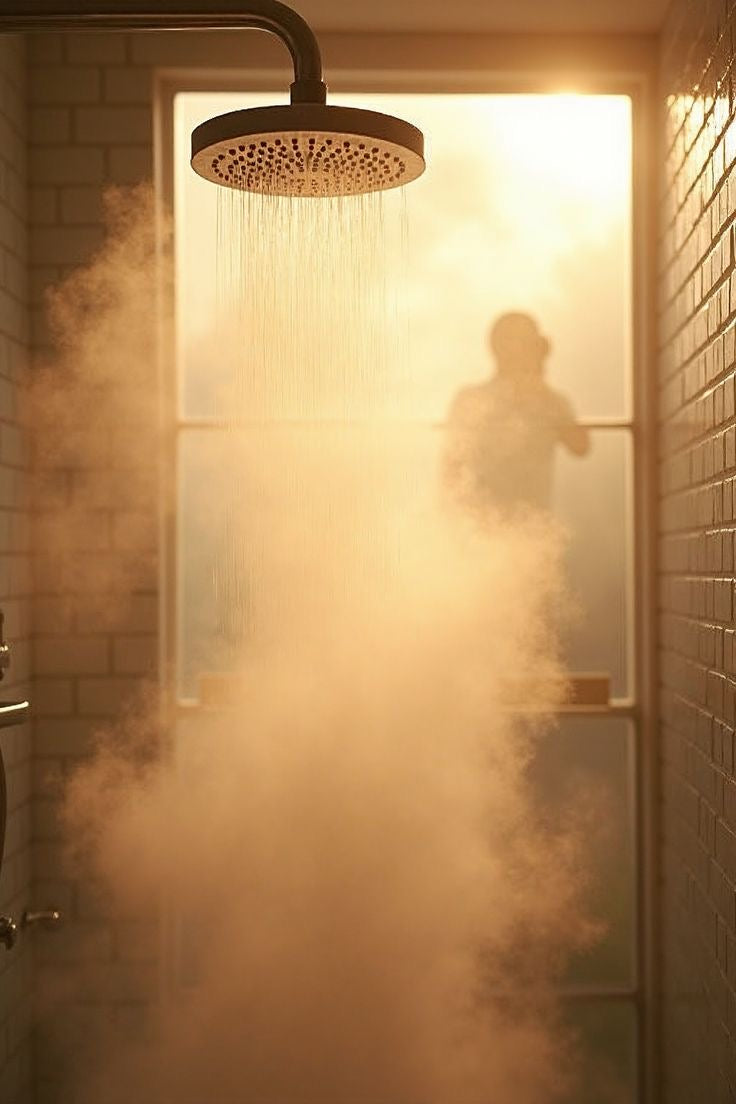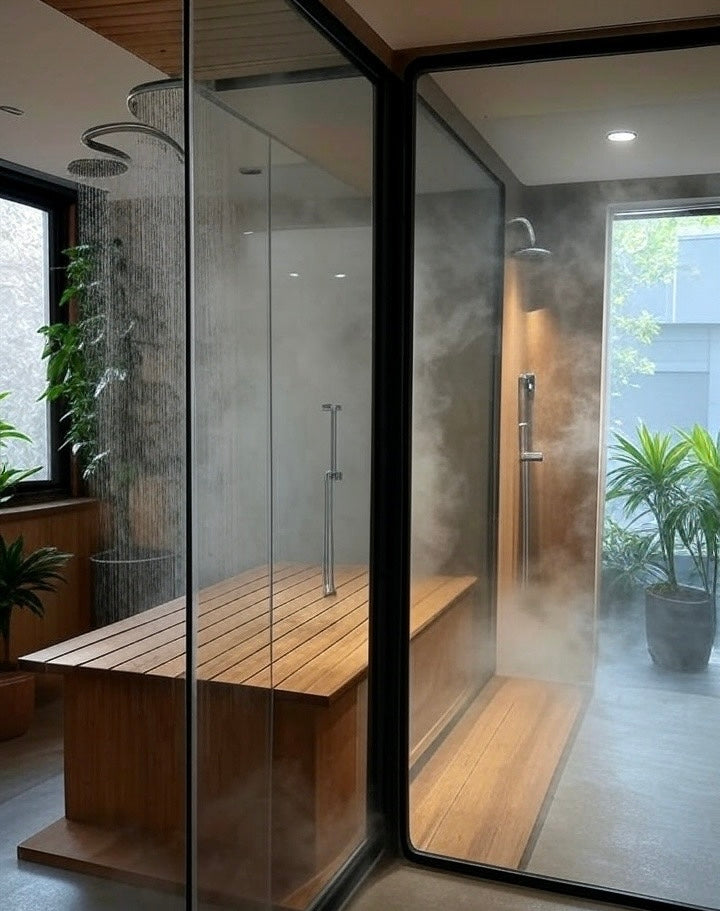Related Posts
Can Steam Room Cause Spots?
Ever left a Steam Room feeling like a glowing goddess—only to wake up with surprise spots? Steam Bath bliss can backfire! Short answer: Yes, steam rooms can cause spots if your skincare routine misses a step. Keep reading to find out why—and how to keep the glow, not the pimples. The Surprising Truth: Can Steam Rooms Really Cause Spots? Steam rooms are often praised for boosting relaxation and leaving your skin glowing.But for some people, that post-steam glow turns into a breakout the next day. The reality is this: yes, steam rooms can cause spots if the skin isn’t properly prepared or cleansed.The mix of heat, sweat, and surface dirt can become a recipe for clogged pores.Still, with the right approach, you can enjoy a steam without the blemishes. The Pros: How Steam Can Benefit Your Skin Steam isn't all bad—in fact, it can be brilliant when used well. Deep Cleansing: How Sweat Works Steam encourages your body to sweat, which helps lift dirt, oil, and debris from the skin’s surface.This can aid in unblocking pores and gently flushing impurities.For many, this results in a fresher, cleaner feeling post-session. Hydration vs. Dehydration: The Steam Room's Role Steam makes the skin feel dewy—but this is often superficial.In reality, it draws water out from your body.If you don’t rehydrate afterwards, skin can end up feeling tight or even dry. Drinking water and applying a light, non-comedogenic moisturiser can help restore balance. The Stress Factor: Reducing Cortisol for Clearer Skin Steam can also help reduce cortisol, the hormone linked to stress and inflammation.Lower cortisol levels may support clearer skin in some people.Relaxing in a steam bath provides not just calm for the mind, but a chance for your skin to reset too. The Cons: When a Steam Room Can Worsen Breakouts For some, steam does more harm than good—especially if your skincare routine slips. The "Pore Opening" Myth: What Really Happens to Your Pores Contrary to popular belief, pores don’t actually “open” or “close”.Steam softens the surface of your skin, making it easier to clear out debris.But if your skin is dirty going in, that heat could just drive impurities deeper. The Overheating Effect: Why Excess Heat Can Inflame Acne Too much heat can lead to inflammation.This may trigger oil production, aggravate acne, and even make blemishes worse.People with active breakouts should limit their time inside or avoid high heat altogether. A Comedogenic Cocktail: The Problem with Sweat and Impurities If you enter a steam room wearing makeup or SPF, you risk creating a pore-clogging mixture.The sweat combines with dirt, oil, and products—creating a layer that clings to your skin.This is one of the most common causes of steam room breakouts. Triggering Specific Conditions: Rosacea and Melasma Certain skin conditions don’t pair well with steam.Rosacea can flare up due to the heat and humidity, while melasma may darken.If you have either, it’s best to check with a dermatologist before stepping in. A Clear-Skin Protocol: Making Steam Rooms Work for You Steam can still be part of your skincare routine—it just needs structure. Pre-Steam Preparation: The Importance of a Clean Face Always cleanse your skin before entering.Remove any makeup, SPF, or dirt to prevent it mixing with sweat.This gives your pores the best chance to purge without trapping grime. During the Session: Hydrate and Limit Your Time Bring water and sip throughout your session.Stick to around 10–15 minutes max—any longer and you risk overheating or irritation.This helps you get the benefits without pushing your skin too far. The Critical "Golden Window": What to Do Immediately After This is the moment your skin is soft, warm, and most absorbent.Gently rinse your face with lukewarm water to remove sweat and any remaining debris.Follow with a light moisturiser or calming serum to lock in hydration. Skincare to Avoid: Spotting Problematic Ingredients Skip products with heavy oils, artificial fragrance, or drying alcohols.These can irritate freshly steamed skin or clog the pores again.Stick with calming, non-comedogenic products to avoid undoing your good work. Takeaways Can steam room cause spots? Yes—especially when used without proper skincare steps. Heat and sweat can clog pores if makeup or dirt are left on the skin. Limit session time, hydrate, and cleanse before and after. People with rosacea or melasma should use steam rooms with caution. A few simple habits can make steam a safe part of your routine. Conclusion Steam rooms can give your skin that post-yoga glow—or trigger a breakout if you're not careful.When done right, they offer skin-cleansing, stress-reducing benefits.But skip the prep, and you might end up with unwanted spots instead. So next time you hit the steam bath, treat it like a mini facial—clean in, calm out, glow on.
Learn moreAre Steam Rooms Good for You?
Ever stepped into a Steam Room and thought, “Is this doing anything besides making me sweat like I’m in a Steam Bath curry pot?”Short answer: Yes—it’s doing wonders! From glowing skin to easier breathing, here’s why steam therapy is more than just hot air. Keep reading for the steamy benefits. The Primary Health Benefits of Steam Rooms Boosts Circulation and Cardiovascular Health Steam therapy may help get your blood pumping in all the right ways. How Moist Heat Affects Blood Flow When you're in a steam room, the heat causes your blood vessels to widen.This allows blood to flow more freely around your body.Improved circulation can leave you feeling warm, loose, and energised.It also helps muscles recover faster after exercise. Potential Impact on Blood Pressure Steam may slightly lower blood pressure due to its calming effect on the body.However, those with hypertension should be cautious.It’s always wise to keep sessions short and stay hydrated. Supports Respiratory and Sinus Health Steam is known to provide relief for the lungs and sinuses. Relieving Congestion and Loosening Mucus The warm, moist air in a steam bath can help clear nasal passages.It works by loosening mucus and reducing inflammation in airways.This makes breathing feel easier, especially during allergy season. Aiding Conditions like Colds and Bronchitis Steam rooms can ease symptoms of colds and mild bronchitis.They support the lungs by relaxing tight airways and breaking down phlegm.People with mild asthma may also find gentle relief—though caution is always needed. Promotes Skin Health and Appearance A glowing complexion might just start with a little steam. Opening Pores and Cleansing the Skin Steam helps open up pores, which allows dirt and oil to escape.It can leave your skin feeling cleaner and fresher.Used regularly, steam may help reduce minor breakouts and even out skin tone. The Role of Sweating in Detoxification Sweating helps flush out surface-level impurities.Though it’s not a major detox pathway, it does promote hydration and surface cleansing.This leaves the skin feeling soft and revived. Accelerates Post-Workout Muscle Recovery After intense movement, steam can offer serious relief. Alleviating Delayed Onset Muscle Soreness (DOMS) Steam improves circulation, which can help reduce soreness after workouts.It delivers more oxygen to tired muscles, aiding in repair.Even 10 minutes can help loosen stiff areas. Relaxing Stiff Joints and Muscles Steam heat can soothe joint tension and soft tissue tightness.This makes it great for gym-goers or anyone with a physically active lifestyle. Aids in Stress Reduction and Mental Relaxation Steam rooms offer a break from your fast-paced world. The Connection to Cortisol and Endorphins The warmth encourages the body to release endorphins.These are your natural feel-good chemicals.At the same time, stress hormone levels—like cortisol—can drop slightly, helping you feel calmer. Creating a Mindful Environment The quiet and enveloping heat of a steam bath promotes mental stillness.It’s a simple space to breathe, reset, and step away from screen overload. Understanding the Risks and Key Precautions Steam rooms are generally safe when used sensibly.But it’s still important to know the limits. Potential Dangers and How to Avoid Them The Risk of Dehydration Steam causes intense sweating, and that means fluid loss.Always drink water before and after your session.Dehydration can lead to dizziness, headaches, or fatigue. Overheating and How Long to Stay in a Steam Room Don’t overstay your welcome in the heat.10 to 15 minutes is usually enough.Longer sessions can raise your core temperature too much and make you feel faint. When to Avoid Using a Steam Room Some people should avoid steam therapy entirely, or get medical clearance first. Specific Medical Conditions (e.g., heart disease, high blood pressure) If you’ve got heart issues, low blood pressure, or are pregnant, it’s best to skip the steam—or get advice before using one. The Importance of Consulting a Doctor When in doubt, always check with your GP.Especially if you’re managing a chronic health condition or taking medication. General Hygiene and Public Steam Rooms Always use a towel to sit on.Make sure the steam room you use is regularly cleaned to reduce bacteria and fungi risks. Steam Room vs. Sauna: What's the Difference? Both feel like a warm hug—but the heat works differently. Key Differences in Heat and Humidity The Environment of a Steam Room Steam rooms are full of moist heat and run at 40–45°C with 100% humidity.The air feels damp, and it’s easier to breathe in if you have sinus trouble. The Environment of a Traditional Sauna Saunas are dry and run at much higher temperatures—up to 100°C.This dry heat makes you sweat more quickly, but the air feels hotter and drier. Deciding Which is Right for You Comparing the Primary Benefits of Each Steam rooms are great for skin health, stress relief, and easing breathing.Saunas are ideal for deep muscle penetration and a stronger sweat. Matching the Experience to Your Health Goals Choose a steam bath if your focus is on relaxation, skin care, or easing congestion.Go with a sauna if you want a more intense sweat or deeper muscle relief. Conclusion So, are steam rooms good for you?Yes—when used properly, they offer a range of physical and mental health benefits. From glowing skin and better breathing to lower stress and muscle relief, steam therapy is a gentle way to care for your body. Just stay mindful of your time, hydrate well, and enjoy the calm it brings. Takeaways Steam rooms improve circulation, skin health, and respiratory comfort. They help reduce stress and support muscle recovery after workouts. Limit sessions to 10–15 minutes and always stay hydrated. Avoid steam baths if you have certain medical conditions—check with your GP first. Know the difference: Steam rooms use moist heat, while saunas offer dry, intense warmth. Let me know if you’d like this turned into a carousel post, email, or short script for a social reel!
Learn moreCan a Steam Room Cause a UTI?
Ever left a Steam Room feeling amazing—then panicked, wondering if that blissful Steam bath could give you a UTI? Short answer: Not directly, but poor hygiene can raise the risk. Steam rooms themselves don’t cause urinary tract infections. If you’re wondering whether it’s still safe to enjoy your steam sessions, don’t worry.Keep reading for the facts and easy ways to stay protected. Understanding the Connection: How a Warm, Moist Environment Can Increase UTI Risk The Role of Bacteria in Urinary Tract Infections The primary culprit: E. coli bacteria. Most urinary tract infections (UTIs) are caused by Escherichia coli, or E. coli for short.This type of bacteria is normally found in the gut but becomes a problem when it enters the urinary tract. How bacteria enter the urinary tract. Bacteria can make their way from the surrounding skin into the urethra, then travel to the bladder.In places like steam rooms, shared surfaces and moisture may contribute to this. Why Steam Rooms and Other Warm Environments are a Concern The warm, moist environment as an ideal breeding ground for germs. Steam rooms are designed to be hot and humid.Unfortunately, these conditions are also ideal for bacterial growth—especially on unclean surfaces. The risks of shared public spaces and lingering bacteria. Benches, floors, and other high-contact areas may carry bacteria from previous users.If not cleaned properly, germs can remain and transfer easily. The link to similar environments: Comparing steam rooms to hot tubs and baths. Steam rooms share many traits with hot tubs and public baths.They involve damp, warm spaces and shared surfaces, where bacteria can survive.The risks are similar—particularly when personal hygiene is neglected. Additional Factors that Compound the Risk Wearing a wet swimsuit for a prolonged period. Sitting in damp swimwear keeps warmth and moisture close to the body.This creates a perfect setting for bacteria to thrive near sensitive areas. Dehydration and its effect on bladder function. When you don’t drink enough water, you urinate less frequently.This gives bacteria more time to multiply in the bladder and increases infection risk. Practical Prevention: How to Reduce Your Risk When Using a Steam Room Before You Enter the Steam Room Shower beforehand for good personal hygiene. Rinsing off helps remove sweat, dirt, and bacteria from the skin.It also reduces what you bring into the steam room with you. Stay well-hydrated to help flush out bacteria. Drinking water before your session helps your kidneys and urinary system work effectively.A well-hydrated body is better at flushing out harmful bacteria. During Your Session Limit your time to avoid dehydration. Too much time in the heat can cause your body to lose fluid.Try to keep sessions under 20 minutes and take breaks if needed. Use a towel to create a barrier between you and the bench. Sitting on a towel reduces direct contact with shared surfaces.It’s a small but important step for hygiene and comfort. After Your Visit Urinate immediately after your session to flush your urethra. Going to the toilet after steaming helps clear any bacteria that may have entered the area.It’s a simple way to protect against infection. Change out of your wet swimsuit into dry clothes as soon as possible. Staying in damp clothing creates a perfect spot for germs to grow.Dry off quickly and wear breathable fabric to reduce the risk. Drink more water to continue flushing your system. Hydration doesn’t stop after the steam room.Keep sipping water to help your body stay balanced and clear out any lingering bacteria. When to See a Doctor Common Symptoms of a UTI Pain or burning during urination. A burning sensation while peeing is one of the most noticeable signs.It may also come with discomfort or pressure in the lower abdomen. Frequent and urgent need to urinate. You may feel like you need to wee constantly—even if you’ve just gone.Only small amounts may come out, and the urge can be intense. Signs of a More Serious Infection Back or side pain, fever, chills, or nausea, which could indicate a kidney infection. If the infection travels to the kidneys, symptoms can become more severe.Pain in your back or sides, fever, chills, or feeling sick should be taken seriously.Seek medical attention quickly if these occur. The Importance of Antibiotics The role of a doctor in diagnosing and prescribing treatment. UTIs usually require antibiotics to clear the infection fully.Don’t try to self-treat—only a GP can confirm what’s going on and recommend the right medication.Delaying treatment can lead to complications. Takeaways Can steam room cause UTI? Not directly—but poor hygiene and shared, moist surfaces can increase risk. Bacteria like E. coli thrive in warm, damp spaces. Sitting in wet swimwear and dehydration also raise your chances of getting an infection. Good hygiene, hydration, and post-steam habits can keep you safe. Know the signs of a UTI and speak to a doctor if needed. You can still enjoy a Steam Room or Steam bath—just steam smart!
Learn more




